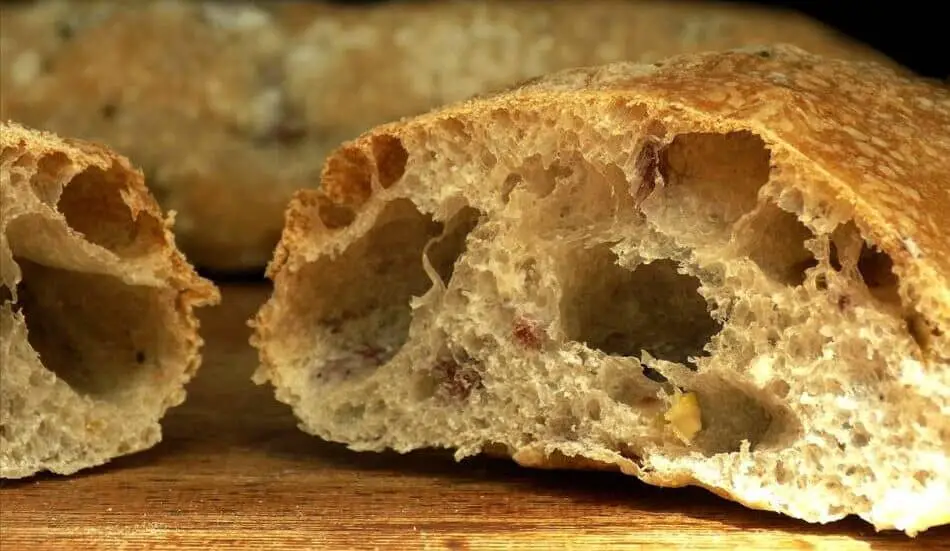The Pan De Cristal is the perfect example of sourdough bread with an extremely light, open and large hole crumb that melts in your mouth, that is wrapped by a thin and crispy crust. Baking sourdough breads such as the Pan De Cristal requires a deep understanding of baking theory and it is considered by many as the holy grail of sourdough bread making.
This article will break down in detail, explaining the reasoning behind the key techniques required to produce a light, open and large hole crumb sourdough bread. The techniques are listed in accordance of descending priority; techniques at the top of the list are more important than techniques at the bottom of the list.
Sourdough bread with a large holes and light open crumb is achieved through strong gas production from fermentation that is not degassed, a highly developed gluten network that traps the gasses, a very extensible dough, and a lengthy fermentation time that lightens and the bread.
10 Most Important Techniques to Bake Sourdough Bread with Large Holes and Light Open Crumb
1. Use of very high hydration (more than 75%)
The most important factor for sourdough bread with a light open crumb and large holes is the use of very high hydration in your dough formula. The use of very high hydration, sometimes upwards to 100% hydration allows the dough to be mixed to very high gluten development while still remaining very extensible (stretchable) and supple.
The highly developed gluten network traps the carbon dioxide gasses in the dough that is released from fermentation and the extensible (stretchable) nature of the dough allows the dough to expand freely to produce very large holes.
Usually at lower hydration levels, the dough becomes excessively elastic (stiff) when mixed to full gluten development. The stiff dough although is able to trap gasses in the dough very well, it is unable to expand freely and hence results in a constricted expansion and smaller holes of the baked loaf.
Wetter dough also ferments better and this is crucial to produce the gasses for the large holes as well as to produce a lighter crumb from the consumption of starches and sugars in the dough.
The importance of fermentation in baking sourdough bread that has a light open crumb and large holes is further discussed in detail in point 5 and 6 below.

2. Bassinage technique for developing gluten in high hydration dough
It is challenging to mix dough of very high hydration to adequate gluten development. You will find that it is hard to incorporate all the water into the dough if done in one mix. An effective method for mixing very wet dough is to hold back a portion of the water when mixing as the gluten develops more readily in a drier environment. This method is known as the ‘bassinage’ in French.
When the dough’s gluten has been developed to a high degree, make a hole in the centre of the dough, introduce the remaining water into the dough and mix only until the additional liquid is incorporated into the dough. This step may be repeated several times for dough of very high hydration, building it up slowly to its intended hydration level.
Mix the dough until surface becomes slightly shiny and moist.
A strong gluten network is fundamental in baking loafs with large open pores as the gluten is impermeable, trapping gas inside it which allows the loaf to rise. Without a strong gluten network, gasses can escape out of the dough, causing poor loaf volume, and a dense, closed crumb with small h oles.
3. Develop additional dough strength through autolyse and folding
High hydration doughs are innately weak and requires all the strength that they can get. Autolyse and folding are crucial steps in the baking process that adds significant dough strength on top of the gluten that has already been developed during the mixing phase.
Autolyse is done before mixing by incorporating only the flour and water (without the salt and sourdough starter) and leave it to rest for about 20 – 60 minutes. During this period, the flour fully hydrates and gluten bonds develops despite the lack of any mechanical mixing; after the autolyse the dough will have gained considerable strength.
The wetter the dough, the more fold is required to build its strength. One fold consists of the folding of all four sides of the dough into its centre. Incorporate one fold for every hour of bulk fermentation.
The length of the bulk fermentation and hence the number of folds, is dependent on how light and open you want the crumb to be; a longer bulk fermentation results in a lighter and more open crumb.
Further discussion on the importance of the length of fermentation is discussed in point 6 below.
4. Do not degas the dough
We should not degas our dough if we desire large holes in the crumb as we are trying to retain as much carbon dioxide gasses from the fermentation reaction in the dough that will expand and give us that airy crumb structure.
The carbon dioxide gasses that are produced also plays an important part in helping the wet, weak and slack dough to hold its shape; very high hydration dough still lacks in strength in spite of good gluten development causing it to not hold its shape well. The carbon dioxide gasses are trapped within the dough and continues to increase the dough’s internal pressure throughout the baking process, inflating the dough from the inside.
Typically when folding a dough of normal hydration, we degas it to prevent an excessive build up of carbon dioxide gasses that can impair the rate of fermentation. However, high hydration doughs ferments better than low hydration doughs, hence degassing is not as important.

5. Strong and healthy fermentation
A strong and healthy fermentation produces sufficient carbon dioxide gasses that expands and gives us the large holes in our crumb structure.
We can ensure a strong and healthy fermentation through the use of a vigorous sourdough starter and fermenting at the appropriate temperature.
A vigorous sourdough starter is achieved from regular feedings and allowing the starter to be fully ripen before incorporating it into the final dough mix. If the sourdough starter is used when it is under ripen or over ripen, fermentation rate is not as vigorous, less carbon dioxide is produced and subsequently we get smaller holes in our crumb.
Signs of properly ripen sourdough starter:
- Loose sourdough starter (100-125% hydration)
It is fully ripen when the surface is filled with many bubbles. It has over ripen when the starter has collapsed, leaving a ‘high water mark’ on the surface of the container.
- Stiff sourdough starter (50-60% hydration)
It is fully ripen when the domed surface is beginning to recede in the centre. It has over ripen when the domed surface has collapsed.
The appropriate temperature for fermentation is at 25 Celcius at which fermentation rate is at its peak. Any deviation from this temperature results in a lower fermentation rate, lower carbon dioxide production, and subsequently smaller holes in our crumb.
6. Lengthy fermentation and cold retardation
A lengthy fermentation time allows the amylase enzymes, yeast and bacteria to eat up the starches and sugars in the dough to reduce the density of the crumb to make it light and open. A lengthy fermentation also enables a considerable amount of acid to be produced through lactic fermentation which provides a very important tightening effect on the dough that increases its strength.
Flour in the dough is made of starches and protein. The protein forms the gluten network which provides the shell structure of the loaf that holds the starches and simple sugars; the starches and simple sugar makes up for most of the crumb’s density and weight.
During lengthy fermentation, the amylase enzymes, yeasts and bacteria has enough time to eat through most of the starches and simple sugar, converting them into ethanol, acid and carbon dioxide gasses. The ethanol, acid and carbon dioxide evaporates when baked and does not contribute to the formation of the crumb structure. Hence, the longer the bulk fermentation, the less starches and simple sugar is in the dough, and the resulting baked loaf will be lighter.
Depending on how light and open you want the crumb to be, bulk fermentation can last upward to 6 hours at room temperature with an additional cold retardation at 5 Celcius for 24 hours.
It is absolutely essential to use a lower percentage of pre-ferment/sourdough starter during the mix (at about 8-10% total weight of flour) as there is less microbial lifeforms when all the ingredients are initially incorporated; fermentation happens at a slower rate over a longer period, allowing the acids to fully develop, strengthening and imparting flavor to the otherwise very wet and weak dough.
For example, if a recipe calls for 500g of total flour with 10% pre-ferment of 100% hydration, that means for that particular dough, the 100% hydration pre-ferment/sourdough starter would consists of a total weight of 100g (50g flour + 50g water). Since the sourdough starter already contains 50g of flour which is 10% of the total desired weight of flour in the formulation, only 450g of additional flour should be added into the final mix.
7. Do not shape and score the dough
Sourdough bread made with very high hydration such as the ciabatta or the pan de cristal are never shaped and scored.
The nature of these very high hydration dough is to be quite weak and slack even with the use of autolyse, folding and the acidity from a lengthy fermentation process. When shaped and scored it is susceptible to collapsing and flattening.
These high hydration dough is considerably weaker than lower hydration dough and it is susceptible to tearing when shaping. Even without shaping, it can tear from rough handling so be gentle when moving the dough from one place to another.
We also do not score dough of very high hydration because it is weak. If scored, the baked loaf will likely collapse and flatten rather than rise upwards.

8. The right amount of steaming
The right amount of steaming is particularly important when baking dough of very high hydration as the dough is weak and more susceptible to collapsing in the oven.
Steaming moistens the surface of the dough, reducing its temperature and delaying the formation of the crust. The amount of steam used controls the timing of when the crust sets.
If too much steam is used, the dough would have over risen and collapsed in the oven before the hard crust sets to provide the external structure to the loaf.
If too little steam is used, the hard crust sets before the dough has fully risen, the loaf’s internal pressure continues to rise from the expanding gasses and eventually leads to unsightly cracks in the baked loaf.
Professional commercial oven has an accurately timed steam injection feature which most of the home bakers do not have access to. We can control the amount of steam in our home oven through controlling the size of the pan that holds the steam water as well as the total steaming time.
Water evaporates quicker when placed in a pan with a larger surface/floor area, hence if we want less steam, use a smaller pan, if we want more steam use a bigger pan.
When the crust has darken sufficiently, that is usually the time we vent the oven to remove all the steam, completing the bake in a dry environment which allows the crust to remain thin and crisp.
9. Do not use rye flour
Rye flour is unable to develop gluten strands and hence will always result in a closed crumb structure compared to wheat bread; without gluten strands, carbon dioxide gasses escapes through the pores of the dough.
Rye flour contains gliadin and glutenin which is the protein molecules that forms gluten, but due to the presence of pentosans, gluten cannot be formed. Pentosans compete with glutenin and gliadin for moisture which prevents the development of gluten.
Even when only a small percentage of Rye flour is used, it could significantly affect the dough’s ability to develop gluten, and will likely flatten the dough.
10. Using properly aged flour
Flour needs to be aged naturally for about 3-4 weeks so that it is sufficiently oxidized. Insufficiently oxidized flour is known as ‘green flour’ and has poor gluten development which results in a close crumb structure with smaller holes as it does not trap the carbon dioxide gasses as well as properly aged flour.
Bleaching of flour is typically done to artificially age it but it loses some of its nutrient which is important for the fermentation process and results in a lower carbon dioxide production and smaller holes.
If you have gone through all the steps above but you are still unable to achieve a light open crumb with large holes, then perhaps your flour is too young. Leave it out for a few more weeks before using it again.

